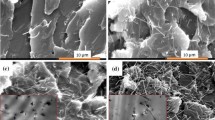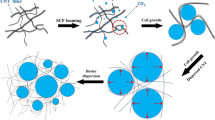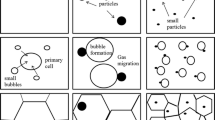Abstract
The high-density polyethylene (HDPE) nanocomposites were prepared by using graphite nanosheets (GNS) and expanded graphite (EG), followed by foaming with subcritical CO2 used as an environmentally benign and nonflammable foaming agent. The partially exfoliated GNS and EG endow the prepared microcellular nanocomposite foams with high electrical conductivity, improved mechanical properties, as well as density reduction up to ca. 20 %. Interestingly, insulator-to-semiconductor transition of microcellular nanocomposite foams shifts to lower nanofiller content compared to that of bulk nanocomposites. Whether the nanofiller is GNS or EG, its incorporation leads to uniformly small cells, resulting in a remarkable enhancement in ductility without sacrificing toughness. It has demonstrated that foaming of HDPE nanocomposites with EG or GNS provides tough and lightweight microcellular foams, exhibiting the potential for use in conductive high-performance lightweight nanocomposite systems.








Similar content being viewed by others
References
Jacobs LJ, Kemmere MF, Keurentjes JT (2008) Sustainable polymer foaming using high pressure carbon dioxide: a review on fundamentals, processes and applications. Green Chem 10(7):731–738
Fugetsu B et al (2008) Electrical conductivity and electromagnetic interference shielding efficiency of carbon nanotube/cellulose composite paper. Carbon 46(9):1256–1258
Im JS, Kim JG, Lee Y-S (2009) Fluorination effects of carbon black additives for electrical properties and EMI shielding efficiency by improved dispersion and adhesion. Carbon 47(11):2640–2647
Zhang H-B et al (2011) Tough graphene–polymer microcellular foams for electromagnetic interference shielding. ACS Appl Mater Interfaces 3(3):918–924
Dehsari HS et al (2014) Efficient preparation of ultralarge graphene oxide using a PEDOT: PSS/GO composite layer as hole transport layer in polymer-based optoelectronic devices. RSC Adv 4(98):55067–55076
Xu K, Chen G, Qiu D (2013) Convenient construction of poly (3, 4-ethylenedioxythiophene)–graphene pie-like structure with enhanced thermoelectric performance. J Mater Chem A 1(40):12395–12399
Zhang Z et al (2015) Template‐Directed In Situ Polymerization Preparation of Nanocomposites of PEDOT: PSS‐Coated Multi‐Walled Carbon Nanotubes with Enhanced Thermoelectric Property. Chem 10(1):149–153
Xu XB et al (2007) Ultralight conductive carbon-nanotube–polymer composite. Small 3(3):408–411
Thomassin J-M et al (2008) Foams of polycaprolactone/MWNT nanocomposites for efficient EMI reduction. J Mater Chem 18(7):792–796
Yang Y et al (2005) Novel carbon nanotube-polystyrene foam composites for electromagnetic interference shielding. Nano Lett 5(11):2131–2134
Ling J et al (2013) Facile preparation of lightweight microcellular polyetherimide/graphene composite foams for electromagnetic interference shielding. ACS Appl Mater Interfaces 5(7):2677–2684
Ye L et al (2009) Synthesis and characterization of expandable graphite–poly (methyl methacrylate) composite particles and their application to flame retardation of rigid polyurethane foams. Polym Degrad Stab 94(6):971–979
Li Y et al (2014) Effect of expandable graphite particle size on the flame retardant, mechanical, and thermal properties of water–blown semi–rigid polyurethane foam. J Appl Polym Sci 131(3):39885
Sorrentino L et al (2012) Mechanical behavior of solid and foamed polyester/expanded graphite nanocomposites. J Cell Plast 48(4):355–368
Celzard A et al (2000) Electrical conductivity of anisotropic expanded graphite-based monoliths. J Phys D 33(23):3094
Zheng W, Wong S-C (2003) Electrical conductivity and dielectric properties of PMMA/expanded graphite composites. Compos Sci Technol 63(2):225–235
Zeng C et al (2003) Polymer–clay nanocomposite foams prepared using carbon dioxide. Adv Mater 15(20):1743–1747
Peacock A (2000) Handbook of Polyethylene: Structures, Properties, and Applications. Taylor & Francis, New York
Pisharath S, Wong SC (2003) Development of the morphology and crystalline state due to hybridization of reinforced toughened nylon containing a liquid-crystalline polymer. J Polym Sci Part B 41(6):549–559
Zhang C et al (2000) Morphology, crystallization and melting behaviors of isotactic polypropylene/high density polyethylene blend: effect of the addition of short carbon fiber. J Mater Sci 35(3):673–683. doi:10.1021/ma071025m
Hoang T et al (2014) Tensile, rheological properties, thermal stability, and morphology of ethylene vinyl acetate copolymer/silica nanocomposites using EVA-g-maleic anhydride. J Compos Mater 48(4):505–511
Wilson R et al (2012) Clay intercalation and its influence on the morphology and transport properties of EVA/clay nanocomposites. J Phys Chem C 116(37):20002–20014
Jolfaei AF et al (2015) Effect of organoclay and compatibilizers on microstructure, rheological and mechanical properties of dynamically vulcanized EPDM/PP elastomers. Polym Bull 72(5):1127–1144
Bidsorkhi HC et al (2015) Preparation and characterization of ethylene-vinyl acetate/halloysite nanotube nanocomposites. J Mater Sci 50(8):3237–3245. doi:10.1007/s10853-015-8891-6
Li YC, Chen GH (2007) HDPE/expanded graphite nanocomposites prepared via masterbatch process. Polym Eng Sci 47(6):882–888
Wang L, Chen G (2010) Dramatic improvement in mechanical properties of GNs-reinforced HDPE nanocomposites. J Appl Polym Sci 116(4):2029–2034
Young RJ, Lovell PA (2011) Introduction to Polymers, 3rd edn. Taylor & Francis, New York
Aboutalebi SH et al (2011) Spontaneous formation of liquid crystals in ultralarge graphene oxide dispersions. Adv Funct Mater 21(15):2978–2988
She Y, Chen G, Wu D (2007) Fabrication of polyethylene/graphite nanocomposite from modified expanded graphite. Polym Int 56(5):679–685
Li J et al (2007) Br treated graphite nanoplatelets for improved electrical conductivity of polymer composites. Carbon 45(4):744–750
Gavgani JN, Adelnia H, Gudarzi MM (2014) Intumescent flame retardant polyurethane/reduced graphene oxide composites with improved mechanical, thermal, and barrier properties. J Mater Sci 49(1):243–254. doi:10.1007/s10853-015-8891-6
Lee LJ et al (2005) Polymer nanocomposite foams. Compos Sci Technol 65(15):2344–2363
Nam PH et al (2002) Foam processing and cellular structure of polypropylene/clay nanocomposites. Polym Eng Sci 42(9):1907–1918
Taki K et al (2004) Visual observation of CO2 foaming of polypropylene-clay nanocomposites. Polym Eng Sci 44(6):1004–1011
Li Y et al (2011) Numerical simulation of polypropylene foaming process assisted by carbon dioxide: bubble growth dynamics and stability. Chem Eng Sci 66(16):3656–3665
Hodlur R, Rabinal M (2014) Self assembled graphene layers on polyurethane foam as a highly pressure sensitive conducting composite. Compos Sci Technol 90:160–165
Realinho V et al (2011) Influence of nanoclay concentration on the CO2 diffusion and physical properties of PMMA montmorillonite microcellular foams. Ind Eng Chem Res 50(24):13819–13824
Tomasko DL et al (2009) Development of CO2 for polymer foam applications. J Supercrit Fluids 47(3):493–499
Zhao Y et al (2007) Preparation and properties of electrically conductive PPS/expanded graphite nanocomposites. Compos Sci Technol 67(11):2528–2534
Lu J et al (2006) The piezoresistive behaviors of polyethylene/foliated graphite nanocomposites. Eur Polymer J 42(5):1015–1021
Van der Putten D et al (1992) Evidence for superlocalization on a fractal network in conductive carbon-black–polymer composites. Phys Rev Lett 69(3):494
Calberg C et al (1999) Electrical and dielectric properties of carbon black filled co-continuous two-phase polymer blends. J Phys D Appl Phys 32(13):1517
Stauffer D, Aharony A (1991) Introduction to percolation theory. Taylor & Francis, New York
Grimmett G (1999) What is percolation?. Springer, Berlin
Balberg I, Binenbaum N, Wagner N (1984) Percolation thresholds in the three-dimensional sticks system. Phys Rev Lett 52(17):1465
Balberg I (1986) Excluded-volume explanation of Archie’s law. Phys Rev B 33(5):3618
Zheng W, Wong S-C, Sue H-J (2002) Transport behavior of PMMA/expanded graphite nanocomposites. Polymer 43(25):6767–6773
Zhai W et al (2012) The orientation of carbon nanotubes in poly (ethylene-co-octene) microcellular foaming and its suppression effect on cell coalescence. Polym Eng Sci 52(10):2078–2089
Ezquerra TA et al (2001) Alternating-current electrical properties of graphite, carbon-black and carbon-fiber polymeric composites. Compos Sci Technol 61(6):903–909
Hu Z, Chen G (2014) Aqueous dispersions of layered double hydroxide/polyacrylamide nanocomposites: preparation and rheology. J Mater Chem A 2(33):13593–13601
Hu Z, Chen G (2014) Novel nanocomposite hydrogels consisting of layered double hydroxide with ultrahigh tensibility and hierarchical porous structure at low inorganic content. Adv Mater 26(34):5950–5956
Gavgani JN et al (2014) Intumescent flame retardant polyurethane/starch composites: Thermal, mechanical, and rheological properties. J Appl Polym Sci 131(23):41158
Bidsorkhi HC et al (2014) Mechanical, thermal and flammability properties of ethylene-vinyl acetate (EVA)/sepiolite nanocomposites. Polym Testing 37:117–122
Dasari A, Yu Z-Z, Mai Y-W (2009) Electrically conductive and super-tough polyamide-based nanocomposites. Polymer 50(16):4112–4121
Collias DI, Baird DG, Borggreve RJ (1994) Impact toughening of polycarbonate by microcellular foaming. Polymer 35(18):3978–3983
Author information
Authors and Affiliations
Corresponding author
Rights and permissions
About this article
Cite this article
Baseghi, S., Garmabi, H., Gavgani, J.N. et al. Lightweight high-density polyethylene/carbonaceous nanosheets microcellular foams with improved electrical conductivity and mechanical properties. J Mater Sci 50, 4994–5004 (2015). https://doi.org/10.1007/s10853-015-9048-3
Received:
Accepted:
Published:
Issue Date:
DOI: https://doi.org/10.1007/s10853-015-9048-3




